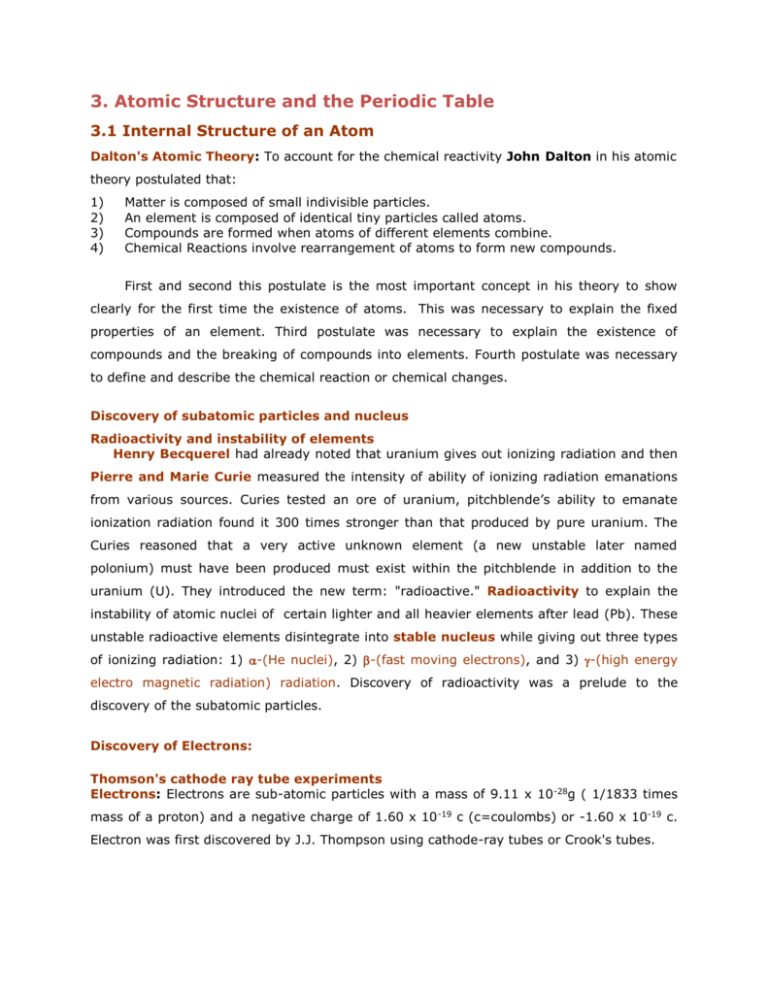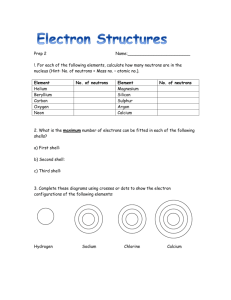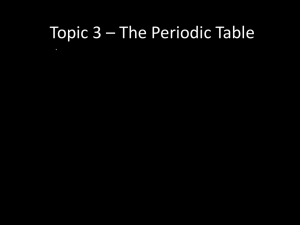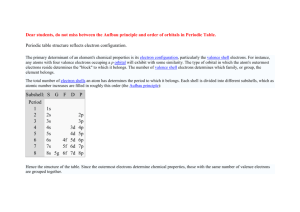Notes-C3
advertisement

3. Atomic Structure and the Periodic Table 3.1 Internal Structure of an Atom Dalton's Atomic Theory: To account for the chemical reactivity John Dalton in his atomic theory postulated that: 1) 2) 3) 4) Matter is composed of small indivisible particles. An element is composed of identical tiny particles called atoms. Compounds are formed when atoms of different elements combine. Chemical Reactions involve rearrangement of atoms to form new compounds. First and second this postulate is the most important concept in his theory to show clearly for the first time the existence of atoms. This was necessary to explain the fixed properties of an element. Third postulate was necessary to explain the existence of compounds and the breaking of compounds into elements. Fourth postulate was necessary to define and describe the chemical reaction or chemical changes. Discovery of subatomic particles and nucleus Radioactivity and instability of elements Henry Becquerel had already noted that uranium gives out ionizing radiation and then Pierre and Marie Curie measured the intensity of ability of ionizing radiation emanations from various sources. Curies tested an ore of uranium, pitchblende’s ability to emanate ionization radiation found it 300 times stronger than that produced by pure uranium. The Curies reasoned that a very active unknown element (a new unstable later named polonium) must have been produced must exist within the pitchblende in addition to the uranium (U). They introduced the new term: "radioactive." Radioactivity to explain the instability of atomic nuclei of certain lighter and all heavier elements after lead (Pb). These unstable radioactive elements disintegrate into stable nucleus while giving out three types of ionizing radiation: 1) -(He nuclei), 2) -(fast moving electrons), and 3) -(high energy electro magnetic radiation) radiation. Discovery of radioactivity was a prelude to the discovery of the subatomic particles. Discovery of Electrons: Thomson's cathode ray tube experiments Electrons: Electrons are sub-atomic particles with a mass of 9.11 x 10-28g ( 1/1833 times mass of a proton) and a negative charge of 1.60 x 10 -19 c (c=coulombs) or -1.60 x 10-19 c. Electron was first discovered by J.J. Thompson using cathode-ray tubes or Crook's tubes. Measuring Electronic Charge: Millikan's oil drop experiments American physicist Robert Andrews Millikan (1868-1953) designed an experiment to measure the electronic charge. He found that electron has a negative charge of 1.60 x 10 -19 c (c=coulombs) or -1.60 x 10-19 c. Discover of Nuclear atom: Rutherford’s a-particle experiment A New Zealander, Ernest Rutherford passed Alpha(-)particles through an extremely thin gold foil. He expected them to go straight through with perhaps a minor deflection. Most did go straight through, but to his surprise some particles bounced directly off the gold sheet! This means there something in the atom that deflected the alpha particles. Rutherford hypothesized that the positive alpha particles had hit a concentrated mass of positive particles, which he termed the nucleus. Nucleus: The mass and the positive (+) charge of an atom are concentrated in the center. This center is called nucleus, and it has radius of about 10-13 cm. Proton: Henry Moseley is credited for the work leading the atomic number and the proton. Proton is a sub-atomic and sub-nuclear particle. A proton has a mass of 1.67 x 10 24 g (which is 1833 times heavier than electrons) and carries a positive charge of 1.60 x 10 - 19 c. Neutron: Chadwick is credited for the discovery of neutron which is a sub-atomic and sub-nuclear particle with a mass of 1.675 x 10-24 g (which is 1833 times heavier than electrons) and carrying no charge. An atom is the smallest particle of an element that determines the physical and chemical properties of that element. An atom has a nucleus a sphere with a very dense center containing the protons and neutrons around which negatively charged electrons move like the planets around the sun. The atom can be thought of as a sphere of empty space where electrons move and 90% of atom’s mass located in the nucleus at the center. protons, neutrons and electrons called subatomic particles. Subatomic particle Mass Charge Electron (e-) 9.109 x 10-28 g 0.0055 amu -1.60 x 10-19 C Proton (p+) 1.672 x 10-24 g 1.0087 amu +1.60 x 10-19 C Neutron (n0) 1.675 x 10-24 g 1.0073 amu * amu atomic mass units 0 Nucleus has a radius of about 10-13 cm. An atom has a radius of about 10-8 cm or 1 Å (angstroms). If an atom were the size of a football stadium, with the electrons out around the upper deck, the nucleus down at midfield would be smaller than the coin flipped at the start of the game. 3.2 Atomic Number and Mass Number Atomic number (Z): Number of protons in a nucleus of an atom is called atomic number (Z). Z is characteristic of an element. An atom of oxygen always has eight protons and atomic number equal to eight. Mass Numbers (A): Number of neutrons and protons together in a nucleus of an atom is called mass number (A). 3.3 Isotopes and Atomic Masses Atoms of an element having different number of neutrons in the nucleus are called isotopes. These atoms of the same element (same Z) have different atoms different Mass Number (A) values. Isotopic symbol: Element symbol (X) found on the periodic table with number of protons or atomic number (Z) written as left subscript, and mass number (A), total of number of protons and neutrons written as left superscript. A X E.g carbon-12: Z or simply written as 12 C 6 C because once atomic symbol is known atomic number could be 12 found easily from the periodic table. Carbon-12 with natural abundance of 99.90% Carbon-13 with natural abundance of 1.10% The average atomic weight of carbon is listed as 12.0107 1 2 H 1 hydrogen-1 3 H 1 hydrogen-2 H 1 hydrogen-3 hydrogen-1 isotope has 1 proton and 1 electron hydrogen-2 isotope (deuterium) has 1 proton, 1 neutron, 1 electron. Hydrogen-3 isotope (tritium) has 1 proton, 2 neutrons, and 1 electron. Average Atomic Mass (A.A.M) Average atomic mass (A.A.M)for an element which is reported on the periodic table is calculated based on the masses of isotopes and their relative composition. Most of the elements have two or more isotopes. Atomic weights based on the masses of isotopes and their relative composition. For example, Gallium in nature consists of two isotopes: Isotope Isotope Mass Fractional Abundance % Abundance gallium-69 (69Ga) 68.926 amu (Ma) gallium-71 (71Ga) 70.925 amu (Mb) Using factional Abundances A.A.M = Ma x a + Mb x b 0.601 (a) 60.1 (%a) 0.399 (b) 39.9 (%b) Using % Abundances = 68.926x(0.601)+70.925 x(0.339) = 69.723 A.A.M. (Ga) = = 69.723 amu or g/mol A.A.M = Ma x %a + Mb x %b 100 68.926x(60.1)+70.925 x(0.39.9) AAM = ------------------------------------100 A.A.M. (Ga) = = 69.723 amu or g/mol Silicon exists as a mixture of three isotopes. Determine its average atomic mass based on the following data to correct significant figure. Isotope Mass (amu or g/mol) Abundance Isotope Isotope Mass Fractional Abundance % Abundance Silicon-28 (28Si) 27.976 9265 Silicon-29 (29Si) 28.976 4947 Silicon-30 (30Si) 29.973 7702 Using factional Abundances 0.9223 0.467 0.310 A.A.M = Ma x a + Mb x b + Mc x c = ___x(___)+ ___x(___)+ ___x(___)=___ A.A.M. (Si) = = ___ amu or g/mol 92.23 % 4.67 % 3.10 % Using % Abundances A.A.M = Ma x %a+ Mbx%b + Mc x %c 100 ___x___+ ___x___+ ___x___ AAM = ------------------------------------100 A.A.M. (Ga) = ___ amu or g/mol Ans:_________ The atomic masses of 35Cl (75.53%) and 37Cl (24.47%) are 34.968 amu and 36.956 amu, respectively. Calculate the average atomic mass of chlorine. The percentages in parentheses denote the % relative abundances. Ans:_________ Chemistry at a Glance: Atomic Structure 3.4 The Periodic Law and the Periodic Table In the early 1800's many elements had been discovered and found to have different properties. Newlands – "law of octaves", a pattern of reactivity follows after 8 elements. However, no one had found a clear "order" in their properties until Mendeleev, Dmitri (1834-1907) arranged 63 then known elements in the order of increasing atomic mass in a periodic table and showed some chemical properties would reappear periodically. In certain cases, he placed a lighter slightly heavier element before a lighter element so that the chemical properties of the vertical columns would be preserved. In Mendeleev's table, there was a gap. He purposely left blank position in his table so that the consistent vertical columns with the same chemical properties would be preserved. These missing elements were later discovered. The periodic law is an organized "map" of the elements that relates their structure to their chemical and physical properties. The periodic table is the result of the periodic law, and provides the basis for prediction of such properties as relative atomic and ionic size, ionization energy, and electron affinity, as well as metallic or non-metallic character and reactivity. The modern periodic table exists in several forms. The most important variation is in group numbering. The tables in the text use the two most commonly accepted numbering systems. Periods and Groups Periods are the horizontal rows of elements in the periodic table; the columns represent groups or families. Elements in a vertical group have similar chemical properties. The vertical groups are currently named by numbers ranging from 1 to 18. An older way to identify the vertical groups is to use a Roman number and the capital letters A or B. Vertical groups of main group elements (or representative elements) were given a Roman numeral plus the letter A. Vertical groups of transition elements were given a Roman numeral plus the letter B. Representative elements are elements that always lose or gain the same number of electrons in chemical reactions. Transition elements are elements that can lose or gain variable numbers of electrons in chemical reactions. Lanthanide series and the actinide series are parts of periods 6 and 7, respectively, and groups that have been named include the alkali metals, the alkaline earth metals, the halogens, and the noble gases. Group A elements are called representative elements; Group B elements are transition elements. Metals, metalloids, and nonmetals can be identified by their location on the periodic table. These groups are number from 1 - 18, left to right and groups have their Roman numbers and A or B classification. 3.5 Metals and Nonmetals Most of the elements in the periodic table are metals. Note the stair step line in the periodic table. Elements to the left of the line are metals. Elements to the right of the line are nonmetals. In between metal and non-metals there are semi-metals or metalloids. Metals lose electrons and nonmetals gain electrons. Problem: Pick the a) representative elements, b) transition elements, c) inert gas elements, d) elements that from anions, e) semi- metals, and f) elements that from cations from the following list: Ca, Si, K, Ar, Cu, Fe Zn, Ge, Kr, Cl, O, F. Answers: a) Representative elements: Ca, Cl, O, F b) Transition elements: Cu, Fe c) Inert gas elements: Ar, Kr d) Elements that from anions: O, F e) Semi- metals: Si, Ge f) Elements that from cations: Ca, K, Cu, Fe Zn Problem: Use your periodic table to find the symbol, atomic number and atomic mass rounded to two decimal place of each of the following elements: a) Magnesium b) Neon c) Selenium d) Gold Answer: Mg, atomic number = 12, mass = 24.31 amu Ne, atomic number = 10, mass = 20.18 amu Se, atomic number = 34, mass 78.96 amu Au, atomic number 79, mass 197.0 amu 3.6 Electron Arrangements within Atoms Basic postulates of Bohr's theory Niels Bohr in 1913, developed a theory describing the possible arrangement of electrons around the uncles of the hydrogen atom to explain emission and absorption electro magnetic radiation (EMR). It has four postulates: 1. An electron in hydrogen atom moves in a circular orbit or shell about the nucleus under the influence of the charged attraction between the electron and the nucleus 2. It is only allowed for the electron to move in a circular shell with increasing distance from the nucleus in the following order: Shell 1-K (n=1), Shell 2-L (n=2), Shell 3-M(n=3), Shell 4-N (n=4), Shell 5-O (n=5), Shell 6-P (n=6), Shell 7-Q (n=7). n is called principle quantum number of the electron. 3. The electron moving in an allowed shell has fixed energy and the energy of the shells increase in the following order: Shell (n=1)< Shell (n=2)< Shell <(n=3), Shell < (n=4), Shell < (n=5), Shell < (n=6), Shell < (n=7). 4. Electromagnetic radiation (EMR) is emitted when the electron, initially moving in a shell of higher energy moves to a lower energy shell or absorbed when moving from lower to higher. What is electromagnetic (EM) radiation (EM)? Electromagnetic radiation is a form of self-propagating waves which does not require a medium to travel. It has its own electric and magnetic field component which oscillate in phase perpendicular to each other and to the direction of energy propagation. Examples of EM radiation include radio waves, microwaves, infrared radiation (IR), visible light, ultraviolet radiation (UV), X-rays and gamma() rays. Of these, radio waves have the longest wavelengths and Gamma rays have the shortest. Higher wavelength shorter the frequency and lower the energy. A small window of frequencies, called visible spectrum or light, is sensed by the eye of various organisms. Which of the following electromagnetic radiation have shortest wavelength? Infrared radiation or radio waves. Which of the following electromagnetic radiation have higher frequency? ultraviolet radiation (UV) or visible light. ] Which of the following electromagnetic radiation have higher energy? Infrared radiation (IR) or gamma() rays. Using Bohr model: Which of the following Shell has the shortest distance to the nucleus? Shell 1-K (n=1), Shell 2-L (n=2), Shell 3-M(n=3), Shell 4-N (n=4), Shell 5-O (n=5), Shell 6-P (n=6), Shell 7-Q (n=7). Ans: Shell 1-K (n=1) Which of the following Shell has the highest energy? Shell 1-K (n=1), Shell 2-L (n=2), Shell 3-M(n=3), Shell 4-N (n=4), (n=5), Shell 6-P (n=6), Shell 7-Q (n=7). Ans: Shell 7-Q (n=7). Shell 5-O Assign the energy change as emission or absorption for the following electron transitions beween shells with certain n= the principle quantum number a) Shell 1-K (n=1) to Shell 4-N (n=4): Ans: Absorption. b) From Shell 5-O (n=5) to Shell 2-L (n=2): Emission. Modifications to Bohr's theory using Wave-mechanical" approach Bohr in his model of the atom assumed electron as particle carrying an negative charge. A new approach treating electron as an wave called Wave-mechanical Model seem to explain much more experimental observations and the arrangement elements in the periodic table. According to new Wave-mechanical model an electron a hydrogen atom has addition features: 1) Each shell could have sub-shells called s, p, d and f. Listed below is sub-shell description of each shell with certain principle quantum number: 2) Each sub-shell s, p, d, f, g , h and i in each shell can have 1,3, 5, 7, 9, 11 and 13 atomic orbital’s. Even though 6ds, 6fs, 7ds 7fs, g and h sub-shells are possible they are never used for electrons in any of the atoms discovered so far and we ignore them. Sub-shells energy order: s< p < d < f < g < h < i. 3) Each atomic orbital can have maximum of 2 electrons with spins (up) and (down). The maximum number of electrons is a given shell is calculated using the formula, 2n 2. 4) The orbital filling order for multi-electron atom: 1s, 2s, 2p, 3s, 3p, 4s, 3d, 4p, 5s, 4d, 5p 6s 4f, 5d, 6p, 7s, 5f, 6d, 7p Summary of Wave-mechanical Model n Shell Sub-shells 1 2 3 4 1 2 3 4 s s, p s, p, d s, p, d, f 5 5 s, p, d, f, g 6 6 s, p, d, f, g, h 7 7 s, p, d, f, g, h, i Atomic Orbitals One s, three p, five d, seven f, nine g, eleven h 1, 3, 5, 7, 9, 11, 13 odd series 1s 2s, 2p1, 2p1, 2p3 3s, 3p1, 3p2, 3p3, 3d1, 3d2, 3d3, 3d4, 3d5 4s, 4p1, 4p2, 4p3, 4d1, 4d2, 4d3, 4d4, 4d5 4f1, 4f2, 4f3, 4f5, 4f6, 4f7 5s, 5p1, 5p2, 5p3, 5d1, 5d2, 5d3, 5d4, 5d5 5f1, 5f2, 5f3, 5f5, 5f6, 5f7, gs 6s, 6p1, 6p2, 6p3, 6d1, 6d2, 6d3, 6d4, 6d5 6f1, 6f2, 6f3, 6f5, 6f6, 6f7, gs and hs Total elens. (2n2) 2 8 18 32 7s, 7p1, 7p2, 7p3, 7d1, 7d2, 7d3, 7d4, 7d5 7f1, 7f2, 7f3, 7f5, 7f6, 7f7 gs, hs and is 98 Multi-electron atom orbital filling diagram: Building up principle of electron configuration: 1s, 2s, 2p, 3s, 3p, 4s, 3d, 4p, 5s, 4d, 5p 6s 4f, 5d, 6p, 7s, 5f, 6d, 7p 50 72 Chemistry at a Glance: Shell, Sub-shell and Orbital Interrelationships. The total number of electrons that can be accommodated in the sub-levels within: a) n = 1 b) n = 2 c) n = 3 d) n =4 e) n = 5 Ans: a) n = 1 (2n1= 1) b) n = 2 (2n2= 8) c) n = 3 (2n2= 18)d) n =4 (2n2= 32) e) n = 5 (2n2= 50) How many orbitals are in the following sub-shells: a) s b) p c) d d) f e) g Ans: a) s (1) b) p (3) c) d (5) d) f (7) e) g (9) How many electrons that can be accommodated in the following sub-shells: a) s b) p c) d d) f e) g Ans: a) s (1 x 2= 2) b) p (3x 2= 6) ) c) d (5 x 2 =10) d) f (7 x 2 =14) e) g (9 x 2 = 18) 3.7 Electron Configurations and Orbital Diagrams Electronic configuration element and the periodic table Electronic configuration of an element: Arrangement of electrons in atomic orbitals in the order of increasing energy. E.g. H :1s1, He :1s2 , C: 1s22s2 2p2 , O: 1s22s2 2p4 Periodic Table and the Atomic Orbitals: Periodic table is useful in getting an electron configuration of an atom since modern periodic table is a direct reflection of filling order of electron into a multi electron atom. Orbital filling order: 1s, 2s, 2p, 3s, 3p, 4s, 3d, 4p, 5s, 4d, 5p 6s 4f, 5d, 6p, 7s Assign atomic orbital block where last electron is added in following elements: a) alkali metals b) alkaline-earth metals c) halogens d) noble gases a) alkali metals(s-block) b) alkaline-earth metals (s-block) c) halogens (p-block) d) halogens (p-block) Electronic configuration for an atom is obtained using following procedure: 1) 2) 3) Number of electron in an atom is equal to its Atomic number: Following atomic orbitals s, p, d , and f can have maximum of 2, 6 , 10 , and 14 electrons respectively. Use the filling order which is obvious in the periodic table: Period number gives principle quantum number, orbital block shows when you add an electron which types of orbital it would be added to. E.g. Oxygen (O) Fill the atomic orbitals starting from lowest 1s and assuming that a s orbital can only take up 2 electrons p orbital six d orbital ten, f orbital 14 etc. Atomic number is 8 therefore it has 8 electrons Orbital filling order: 1s, 2s, 2p, 3s, 3p, 4s, 3d, 4p, 5s, 4d, 5p 6s 4f, 5d, 6p, 7s Only fist three lowest energy atomic orbitals are used for 8 electrons. O: 1s2 ….two in 1s orbital …. 2s2 two in 2s orbital and ….remaining 4 electrons in 2p orbitals 2p4 Electronic configuration of O: 1s22s2 2p4 What is the electron configuration of atoms of flowing elements: In, Co and Ca? In Atomic number is 49 therefore it has 49 electrons Orbital filling order: 1s, 2s, 2p, 3s, 3p, 4s, 3d, 4p, 5s, 4d, 5p 6s 4f, 5d, 6p, 7s Only fist eleven lowest energy atomic orbitals are used for 49 electrons. In: 1s2 ….two in 1s orbital …. 2s2 two in 2s orbital and ….remaining 6 electrons in 2p orbitals 2p6..etc. Electronic configuration of In: 1s2,2s2,2p6,3s2,3p6,4s2,3d10,4p6,5s2, 4d10,5p1 Electronic configuration of Co: 1s2,2s2,2p6,3s2,3p6,4s2,3d7 Electronic configuration of Ca: 1s2, 2s2, 2p6 Valence shell electronic configurations Complete electronic configurations shows how electrons are added to the sub-shell of lowest energy until it reaches its capacity. The most important shell of electrons in the atom fro the chemical reactivity is the outermost shell: The valence shell. Valence Shell electronic configuration is written by summarizing the inner shell or core electron configuration using form what we call inert-gas core format. Complete electronic configurations C: 1s22s2 2p2 O: 1s22s2 2p4 In: 1s2,2s2,2p6,3s2,3p6,4s2,3d10,4p6,5s2, 4d10,5p1 Co: 1s2,2s2,2p6,3s2,3p6,4s2,3d7 Ca: 1s2, 2s2,2p6,3s2,3p6,4s2 Electronic configuration in inertgas core format. C: [He] 2s2 2p2 O: [He]2s2 2p4 In: [Kr] 5s2, 4d10,5p1 Co: [Ar]4s2,3d7 Ca: [Ar]4s2 Complete electronic configurations: C: 1s22s2 2p2 O: 1s22s2 2p4 Electronic configuration in core format: O: [He]2s2 2p4 Give the valence electron configuration in core format of following atoms: a) Na b) Cl c) P d) O Valence-shell Electron Configuration: Electron configuration of the outer most shell (maximum n) Ans: a) Na: [Ne] 3s1 b) Cl: [Ne] 3s2,3p5 c) P : [Ne] 3s2,3p3 d) O : [He] 2s2,2p4 Valence shell orbital diagrams Shows how electrons the details of the Complete electronic configurations and the valence shell. Here we mainly focus on Valence shell orbital diagrams. Electronic configuration in inert-gas core format. Valence shell orbital diagrams 2s2 C: [He] 2s 2p 2 2 2p4 2s2 O: [He]2s2 2p4 2p4 In: [Kr] 5s2, 4d10,5p1 2s2 4d10 5p1 Co: [Ar]4s ,3d 2 7 4s 3d 2 Ca: [Ar]4s 2 42s 4p 2 7 0 3.8 The Electronic Basis for the Periodic Law and the Periodic Table Representative elements: s-block and p-block elements that always lose or gain the same number of electrons in chemical reactions. Transition elements: d-block elements that can lose or gain variable numbers of electrons in chemical reactions. Lanthanide series and the actinide series: f-block elements are parts of periods 6 and 7, respectively. 3.9 Classification of the Elements in the periodic table a) Alkali metal: Li, Na, K, Rb, Cs, and Fr Valence Li, Na, K, Rb, Cs, Fr ele.n conn 2s1 3s1 4s1 5s1 6s1 7s1 b) Alkaline Earth Metals Be, Mg, Ca, Sr, Ba, and Ra Valence Be, Mg, Ca, Sr, Ba, Ra ele.nconn 2s2, 3s2 4s2 5s2 6s2 7s2 c) Halogens: F, Cl, Br, and I Valence F, Cl, Br, I ele.n conn 2s22p5,3s22p5,4s24p, 5s25p5 d) Noble gases: He, Ne, Ar, Kr, Xe and Ra Valence He, Ne, Ar, ele.nconn He :1s2, Ne:2s2 e2p6, Ar: 3s23p6, Kr, Xe Ra Kr:4s24p6, Xe:5s25p6, Ra:6s26p6 Loose one electron and get noble gas electron configuration and forms mono positive cations Loose two electron and get noble gas electron configuration and forms di-positive cations. Gains one electron and achieve noble gas configuration gains andone forms electron monoand positive achieve anions noble gas Have closed shell electron Have closed shell electron configurations. Do not loose or gain electrons. Alkali metals: ns1-group alkaline earth metals: : ns2 -group, the halogens, and the noble gases. Group A elements are called representative elements; Group B elements are transition elements. Metals, metalloids, and nonmetals can be identified by their location on the periodic table. Chemistry at a Glance: Describe Element Classification Schemes and the Periodic Table Chemical Connections: Describe heat Protium, Deuterium, and Tritium: The Three Isotopes of Hydrogen; Importance of Metallic and Nonmetallic Trace Elements for Human Health; Electrons in Excited States







